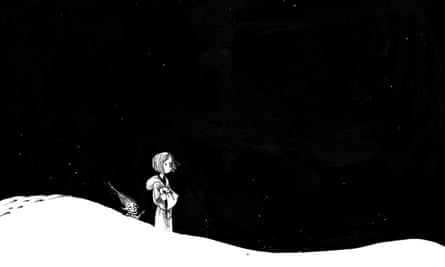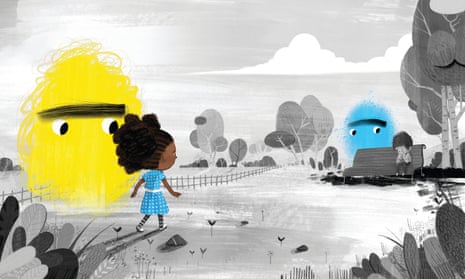Matt Haig is feeling hopeful. His first ever illustrated story, The Truth Pixie, is published in the UK on Thursday – and he is optimistic it will encourage young children to talk about their anxieties. “It’s a book I want parents to share with their children – a read-aloud bedtime story,” Haig says. “Bedtime is a time when children’s heads are full of fears, and those don’t go away by just ignoring them. They go away by talking about them, externalising them and dealing with them.”
While his books for children are usually full of jokes, Haig’s bestselling non-fiction titles for adults, Reasons to Stay Alive and Notes on a Nervous Planet, both explore his own struggles with mental illness. He says The Truth Pixie is “Reasons to Stay Alive for seven-year-olds – but with trolls and elves and silly jokes thrown in”.
The book confronts feelings of anxiety head-on, using the metaphor of a cursed pixie who is forced to tell hard-hitting truths to a sad little girl who is very anxious about her future. It’s a story to be read in one sitting, Haig continues, which “ends on a friendship and a positive thought about the future – that idea that, yes, this might be a bad day, but there are going to be so many brilliant days. And actually, you need the occasional dark day for the bright days to be brighter.”

Haig is not the only children’s author who wants to help young readers learn to cope with their mental health problems. With one in four children who are referred to child and adolescent mental health services (CAMHS) turned away, a wave of illustrated fiction is attempting to help children as young as three manage their feelings of worry and stress.
“Childhood is not always a carefree time and lots of children face challenges they have to overcome,” says Tom Percival, author-illustrator of Ruby’s Worry, a picture book for three to six-year-olds. Published in July, it tells the story of a little girl whose worry follows her around, growing steadily bigger and more upsetting, until she opens up about it to a friend. “I deliberately didn’t make it about a specific problem,” Percival explains. “I wanted to explore the idea of worry, concern and anxiety.” When Ruby is worrying, the world around her is muted in dark shades of grey. But when she shares her worry, a rainbow of colour explodes on to the page and her worry shrinks away until it is “barely there” at all.
Percival hopes the book will help to start conversations. “When I ask my kids how school was, they tend to reply, ‘Yeah, fine’. It’s not until a few days later, quite often at bedtime after we’ve read a story, that I hear how actually, so-and-so had said something to upset them.”
In Charlie Changes Into a Chicken, an illustrated novel for six to 11-year-olds that will be published in February, a young boy starts involuntarily changing into animals whenever he gets stressed and panics. Charlie’s brother is seriously ill in hospital and there is a clear disconnect between what Charlie is going through at home and the mask he is expected put on for school. “Dealing with big problems can also be wrapped up in embarrassment,” says the book’s author Sam Copeland, “and you end up compartmentalising. Teachers are exhausted and overworked and they may just see naughty children acting up, while behind the scenes there’s often something really difficult going on. ”

Over the past four years, more than half (55%) of referrals to CAMHS have come from primary schools, with teachers reporting that children as young as three are now self-harming.
“It’s heartbreaking,” says Percival. “Teachers are having to absorb a huge amount of responsibility, above what people traditionally see as the role of the teacher. They are having to be the mental health guardians of children in schools.”
Constantly reassuring children that everything is fine is short-sighted, Haig believes, because it doesn’t help them to develop coping strategies and mental resilience. “It’s a natural instinct for parents to want to shield young children from everything. But it’s just putting off the problem.” Instead, he recommends telling kids that the world might not be OK – but as individuals they will be, because they will find a way to adapt. “When I was in a state of depression, there was nothing more depressing than reading about perfect happiness and unicorns and rainbows. You want to take someone in an even worse situation than you and then watch them deal with it. Then there’s a comfort.”
Haig says he started to write a non-fiction self-help book about mental health for children, but ended up feeling he was patronising his readers. “I thought I would take the same messages and put them into fiction and it would be more entertaining that way – and maybe more empowering, too.”
Copeland agrees that fiction offers another route to talk about difficult subjects. “Children are less likely than adults to pick up a non-fiction book about anxiety and mental health issues – fiction can be used as a back door into those topics.” But he is keenly aware there are limits to what authors and teachers can achieve alone. “Mental health is a huge problem,” he says. “There should be as much help for children as we can possibly give. Children’s fiction could be used, of course, as a starting point. But for kids with more serious issues, the funding should be there through the NHS to help.”
Haig is worried the situation is getting worse: “All the stuff we expect to see in teenagers is now being seen in younger and younger children. There’s a massive mental health problem in terms of the education system. Even seven-year-olds are thinking about testing, thanks to school league tables. Children don’t feel like they’re valued as children. They have become these test machines.”
For him, children’s fiction provides a non-threatening way for children to reflect on their lives in a place no one else can reach: their own heads. “Imagination is the flipside of anxiety. Obviously if you’re anxious, you’re imagining stuff all the time. You need to fill that imaginative space with positive, fun, nourishing stuff and books can give you that. Through fiction, you can escape into a world that isn’t your life, but can help you to deal with it. And that applies as much to a seven-year-old as it does to a 70-year-old.”
